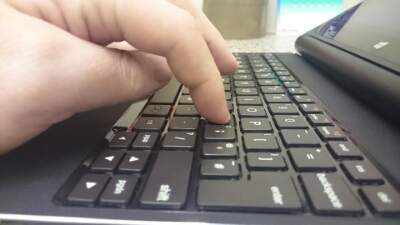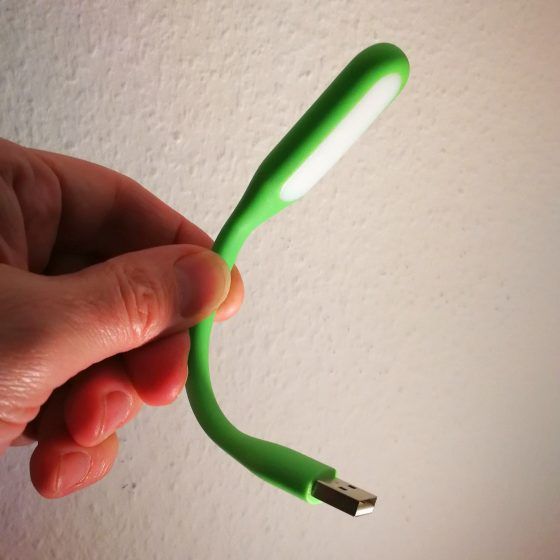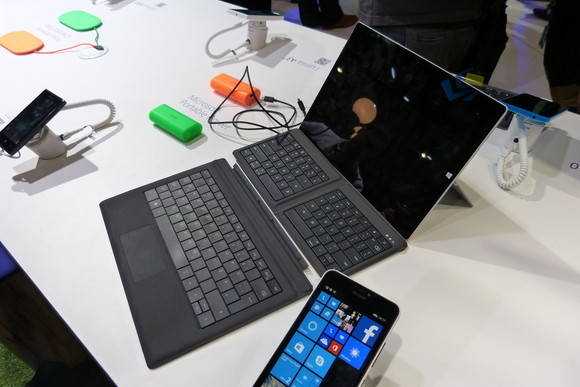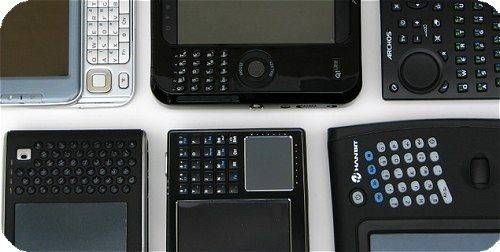One of the great features of an ultra mobile PC (UMPC) is the wide and personal choice of input methods. You can choose a very personal computer tailored to how you work, where you want to work.
Combining touchscreens, thumb-boards and keyboard accessories in multiple ways is why UMPCs can go from desktop to car to bed to garden to bus and provide you new ways and new places to be entertained, in a productive and a comfortable and efficient manner.
Along with battery life, weight and processing platform, choosing a keyboard is one of the most important decisions you’ll have to make when buying a UMPC. The starting point is to decide whether you need a keyboard at all because given the right operating system and touchscreen type, its possible to use on screen keyboards or handwriting recognition but in this article we look at physical keyboards. Both on-device and as accessories.
As you can see in the picture above, keyboards come in many forms and choosing one is a difficult trade-off between input speed and device size. In general, a bigger keyboard area means more typing comfort but it can affect the device size dramatically.
Most UMPCs that have keyboards implement some form of thumb-driven keyboard although there are devices that are built around a traditional notebook form factor and include reduced-size standard keyboards. As a user, you have to decide how important the keyboard is to your usage scenario. The best advise to anyone is to tell them to go out and buy a simple, low cost ultra mobile PC on which to learn how and where you will use it.
If you’re not sure that you need a ultra mobile PC but you think you might get some advantage or enjoyment from one, my recommendation is to buy one anyway. No more waiting! We’re seeing more and more devices go under the $800 mark and new offers are coming in all the time so take advantage of this, buy a device and start to learn! UMPCs aren’t simple devices. You can not simply map your notebook PC usage on to a ultra mobile PC because you will end up being inefficient and will certainly miss out on many of the advantages that a ultra mobile PC brings. If you buy a ultra mobile PC now, you will have 6-12 months to work out how you actually use a ultra mobile PC in your real life.
Understanding how you use a ultra mobile PC will help a great deal in choosing the right device. Enjoy 13 tips for choosing a keyboard below. Have a read through it and then think again about your own usage scenario.

Don’t trust short-term reviews
Mini keyboards are nearly always awkward to use on the first attempt. They look strange, feel strange and if you come from a notebook world where 19mm pitch (the distance between the center of each key) is the norm, they are slow.
Mini keyboard get better over time. Sometimes it’s as little as a week before the operation get faster and more comfortable but in other cases it takes months. Long-term test feedback is very valuable if you are choosing a keyboard.
Numerics
There are a number of keyboards available that combine numeric keys as a second function of another key. In a world where numbers are important, having to deal with second-function numerics is not efficient. Look for a keyboard that has a separate row of numerics or a small numeric pad.
Keyboard Backlights
You will often find yourselves in low-light situations and without backlighting, you can have a problem. Especially with all black devices. The brightness of the screen in low-light situations causes the keys to become almost invisible. One important note here is that keyboard backlighting needs to be central on the key-cover. If it’s not, you’ll be hitting the wrong part of the key in the dark. Front lighting is also an option and it ranges from built-in options (on very few devices) to a simple flexbile USB LED Lamp.

Mouse pointer
An important part of controlling most devices is the mouse. Many devices rely on the touchscreen to provide mouse input but my recommendation is to look for additional mouse control. Built-in optical mouse sensors can vary in accuracy. Build tolerances are tight on these optical devices and you might find that it doesn’t work as expected.
Mouse touchpads are one of the easiest input methods and help with the learning-curve but small touchpads can be frustrating to use. Finally, there’s the Synaptics mouse pointer. There are other brands but ‘Synaptics’ really have mastered the engineering over the years; They generally have better features (tap to click, tap and hold) and a good set of adjustments through the supplied application over other mouse pointer solutions. Mouse pointers aren’t as quick to learn as mouse pads but over the long term,many people find them to be the best and most reliable solution.
Programmable keys
Programmable keys are a great way to speed up operations in a way that exactly fits your working practices. Being able to hit a single key for CTRL-T in a browser is a quick way to open a new tab for example. If the F11 key is missing on your keyboard, being able to program it in provides easy access to the fullscreen button implemented in many programs. Programmable keys may not be necessary on a full keyboard but they are a real advantage if you have them.
Special Keys.
Many keyboard provide special functions like screen brightness, volume, screen resolution change and on-screen menus. In general, screen brightness is the most important but keep an eye out for these features. Locking buttons, rotation buttons, LAN/WAN on/off buttons and shutter release buttons all have great value.
Shortcuts
When we use software on the desktop, we generally just pick up the mouse and go using menus and right-click functions but when using the same application on a ultra mobile PC it pays to learn shortcuts. Some shortcuts are only accessible through special keys like the Windows key or ALT. Don’t forget that shortcuts can have shortcut keys assigned to them. (click image right to enlarge.) Learning even the basic OS shortcuts like ‘tab’ for advancing to the next input field on a browser form can really speed up the way you use the device. Easy access to Windows, ALT, CTRL and FN keys helps out with shortcuts.
Missing or hidden keys.
Make sure those important keys are on the keyboard and not hidden as second-function/multi-press keys. TAB, Windows Key, Function keys (all the way up to F12 if possible) ALT-Gr for those in countries where many special characters and signs require it, ESC and even DEL. Even the print-screen key catches me out sometimes although not many people could justify dedicating a single key to it.
Split keyboards.
Split keyboards are among the hardest of keyboard layouts to learn which is perhaps the reason why you won’t find many.
At first you’ll find your eyes darting around and I know people that have complained of dizziness as a result. They do have advantages though. When holding a device with two hands on the side as you have to do with larger 5-7″ screen devices, the thumbs are perfectly positioned and for triggering URLs from history or entering passwords they are perfect. Over time, too, if you can reach a point where you can blind type (by just looking at the screen) they can be surprisingly fast and comfortable but there are some specific issues to look out for. There are left handed and right handed space-bar users. I use the spacebar almost exclusively with my right thumb so when I find a device with a split keyboard that has a single space button on the left had side, I’m lost! A far more flexible solution is to place the spacebar on both sides. A similar principle applies to the shift button but is far more important than the spacebar as you need two hands to operate it. A sticky shift key is a workaround but slows-down input considerably. Split keyboards should be considered when you do a lot of browsing and reading and where your text entry is limited to short emails, instant messaging or URL, password and form entry.
Sticky keys
Sticky keys are important. If you’re holding your device with two hands, doing a two-button simultaneous keypress can be hard. Sticky keys (for example a sticky Windows button is a real help. Num-lock button can help with hidden numerics.) Windows has a built-in sticky keys function (press your Shift key five times in quick succession to test it out) but I prefer that this is built into keyboard hardware.
Click characteristics
Have you ever pressed a key and thought it was pressed but it wasn’t? Or have you ever pressed a key and got double registration (known as key-bounce.) It’s to do with the key mechanics and anti-bounce electronics and its very very important. Having the correct amount of click pressure and feedback is also important. The worst example of this was the early Kohjinsha SA1 that had keys that required an additional push at the bottom of the keystroke in order to register a key-press. If you didn’t change your typing style to accommodate this, the keyboard was next to useless.
Key size vs key pitch vs key shape.
You need to consider your finger type when considering keys. For people with big fingers. tiny button keyboards are useless. Even mini notebook keyboards could be a problem. It’s not the key size that causes problems, its the key pitch and the key shape. The key pitch is the distance between the centers of a key. Normal keyboards use a 19mm pitch. Mini keyboards are down at 17mm and that’s about as close together as most people can go and still find it possible to touch type. The key shape is an important factor in helping the thumb feel the center of the key which ultimately, enables blind typing. Even if you have a nice 13mm keypitch, if you cant center your thumb or finger on the keypress, the accuracy drops off.
Dont forget portable keyboards.
One of the highlights of an ultra mobile PC is that you can combine different input methods for different situations. Having a touchscreen, a thumb-board and carrying a mini or folding USB/Bluetooth keyboard in addition, gives you the choice of inputs that match your scenario.

Three more things – be patient, be flexible, think differently.













